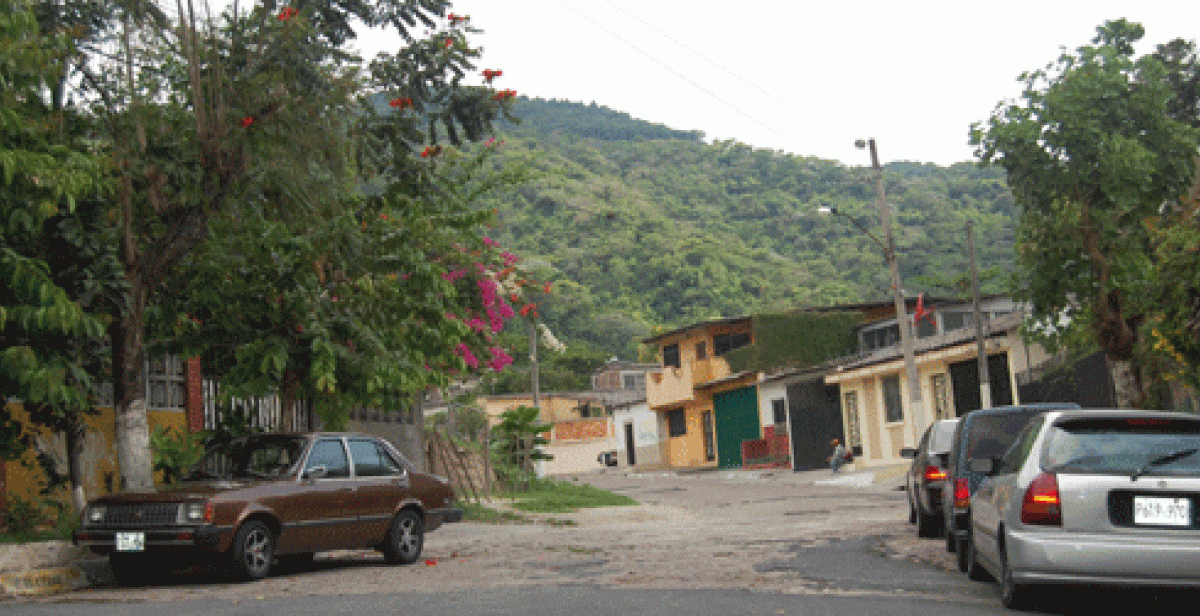“The San Jacinto Hill serves as the lungs of San Salvador”, says Hector Mauricio Flores, and his colleagues nod their heads in agreement.
It’s a rainy Saturday afternoon, and we are gathered in a small circle in a side room of the Community Meeting House of Santa Marta, one of the various communities that form part of the San Jacinto neighbourhood of San Salvador.
It’s misty outside, and the slope that the meeting place is on is slick with mud. In the larger meeting room, community members are distributing shovels, galoshes, rain slickers, and other materials donated by a local environmental organisation to help prepare for potential disasters caused by the vulnerable conditions the people of these communities live in.
The conversation weaves between the beginning days of the struggle defending the hill, jumping forward to the current challenges of pollution, climate change, risk management, and twisting back to before it all began.
Maria Rosario Azucena lifts her hand to speak. She begins “I remember in the 1970s when the hill was just a forest. I remember that there were Conacaste trees, Pine trees, and there were waterfalls and a spring, with pools of water.
"People would drink the water from this spring…it was cool and refreshing, and there were many kinds of birds.” Hector Mauricio is sitting next to her and adds, “People would grow beans, corn, and coffee on the hill.”
The forest on the Hill where they all lived was being eaten away by housing construction. In the face of this threat, community members from several smaller neighbourhoods in the area joined forces.
I can hear the pride in their voices as they tell me about this time, which is what they identify as the beginning of the fight to save the San Jacinto Hill. “It was very powerful to see seventeen communities come together to defend the San Jacinto Hill,” reflects Isaura Ayala. “I remember the last march, when they shot at us over there by the President’s House. We all went home and there were probably about 5,000 of us from 17 different communities, from here and from the neighbourhood of San Jacinto. “
As time went by, the community continued to unify forces in the face of other threats to their beloved forest, from a rock quarry shortly afterward, to the construction of a four lane highway intended to circle the San Salvador Metropolitan Area in 2004.
They organized themselves with other communities that would be affected by the construction of the highway, in the Association of Communities Affected by the Periphery Highway (ACAP for its initials in Spanish) and to this day have managed to stop further construction.
“But now,” comments Orlando Quintanilla, “Now we are seeing the consequences of so many years of mistreatment of the Hill: the construction, deforestation and pollution. The consequences are sinkholes, landslides, and flooded rivers. It all comes flowing down from the hill into the communities as now there is nothing to hold the water back; it comes down with all its force.
We have to stop the construction higher up the hill because of the impact it has on the communities below. Now we are 8 communities and we have risen up and come together, to face the consequences of the destruction of the forest.”
Blanca Díaz has lived in San Jacinto for her whole life, and shares her home with her 5 children and 4 grandchildren.
She, her two daughters, and her 5 year old grandson are active participants in community events and the National Environmentalists Network, which is a grassroots organization made up of communities who face various environmental issues.
As the conversation shifts more to our visions and hopes for the San Jacinto Hill, she shares, “I’m not in this just for me, I also think of my grandchildren. I have faith that this will change, and we have to struggle for our children’s sake. I am struggling for the San Jacinto hill, with a devotion to serve and struggle as an environmentalist.
"I want to achieve something, and I want the hill to be declared a protected zone. We work with the communities living in risk at the foot of the volcano, too. We are struggling, not just for our own communities, but for everyone”.
Maggie von Vogt is a development worker based in San Jacinto, San Salvador.
Photo: San Jacinto hill. Maggie von Vogh/ Progressio



